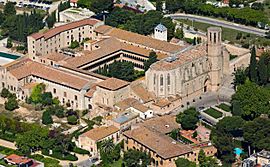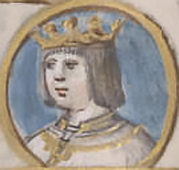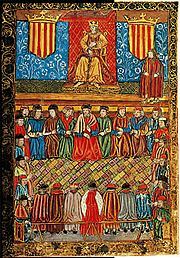Catalan Civil War facts for kids
Quick facts for kids Catalan Civil War |
|||||||
|---|---|---|---|---|---|---|---|
|
|||||||
| Belligerents | |||||||
|
|||||||
| Commanders and leaders | |||||||
| Henry IV of Castile Peter, Constable of Portugal René of Anjou |
John II of Aragon | ||||||
The Catalan Civil War was a big fight within the Principality of Catalonia (a region in modern-day Spain). It happened between 1462 and 1472. At that time, Catalonia was part of the Crown of Aragon, which was a group of kingdoms ruled by one king.
The war was between two main groups. One group supported King John II of Aragon. The other group, called the Catalan constitutionalists, wanted to protect Catalonia's special laws and rights. They believed the king should follow these rules. Sometimes, France helped King John II, and other times they helped the Catalans.
The Catalans first supported John's son, Charles of Viana. When he died, they chose other people to be their king instead of John. The city of Barcelona was their main stronghold until the very end. When Barcelona surrendered, the war finished. King John II won, and things mostly went back to how they were before the war.
Both sides thought the other was wrong. The king's supporters saw the Catalans as "rebels" who broke their promises to the king. The Catalans saw the king's supporters as "traitors" because they didn't respect Catalonia's laws. This war helped create a new idea of what a "homeland" meant. It wasn't just about sharing a ruler, but about sharing laws and living in the same land.
Contents
Why Did the War Start?
King John II and His Son Charles
The war began because of problems between King John II and his oldest son, Charles. John II became King of Navarre in 1425 through his first wife, Blanche. When Blanche died in 1441, John kept ruling Navarre instead of letting Charles, who was the rightful heir, take over.
Charles was known as the Prince of Viana. John tried to make peace by letting Charles be in charge of Navarre, but they still argued. They even fought a small war in Navarre in the early 1450s. Charles was captured but later released.
John tried to stop Charles from becoming king by saying his daughter, Eleanor, would be the next ruler. This was against the rules. In 1451, John's new wife, Juana Enríquez, had a son named Ferdinand. This made the situation even more complicated.
Charles Seeks Support
In 1452, Charles left his father and went to France, then to his uncle Alfonso V's court in Naples. When Alfonso V died in 1458, John II became the ruler of the Crown of Aragon. John's will said Charles would be his heir.
One of John's first unpopular actions was stopping a war against Genoa, which upset Barcelona's merchants. He also didn't help his nephew, Ferdinand I, keep his throne in Naples.
In 1460, Charles returned to Barcelona without permission. He was welcomed by two important groups in the city: the Busca (merchants and workers) and the Biga (rich citizens and landowners). John didn't react right away. He called Charles to his court to talk about Charles marrying Isabella of Castile.
John still refused to call Charles his "first born" son, probably wanting that title for Ferdinand. This made many people angry. Charles then started talking with Henry IV of Castile, who was John's enemy.
Charles's Arrest and Catalan Reaction
On December 2, 1460, Charles was arrested and put in prison. This caused a huge outcry in Catalonia, where Charles was very popular. The king had to stop his court meetings.
The Generalitat (Catalonia's main government body) and the Consell de Cent (Barcelona's city council) created a special council to decide who should be the rightful heir. The Catalan parliament was called to meet on January 8, 1461.
At the parliament, a legal expert named Joan Dusai said the king had broken several important Catalan laws and rules. The parliament demanded that John name Charles as his first son and heir. John refused. So, the parliament gathered an army.
The army quickly captured a town called Fraga. John had to give in. He freed Charles on February 25. On June 21, they signed an agreement called the Capitulation of Vilafranca. In this agreement, Charles was recognized as John's first son, his permanent representative, and heir to all his lands.
The king also gave up his right to enter Catalonia without the Generalitat's permission. He also had to let Catalan bodies advise him on who to appoint as royal officials. This treaty was a big win for the Catalans who wanted to protect their independence and old privileges.
Charles's Death and New Problems
Charles died of tuberculosis in Barcelona on September 23, 1461. This put the treaty in danger. Charles had brought the Catalans together, but his death caused new divisions.
The treaty said that Ferdinand, who was only nine years old, could take over after John. But Ferdinand's mother, Juana, was secretly working to overturn the treaty. She worked with the Busca group against the Biga.
The Remences Revolt Begins
Peasant Uprising and Royal Support
The civil war truly began with the War of the Remences in February 1462. This was a revolt by peasants led by Francesc de Verntallat. These peasants hoped to get the king's support against the Consell del Principat. Queen Juana actively tried to stir up anti-Busca feelings in Barcelona.
In April, a plan by some former Busca members to support the queen was discovered. The deputy leader of the Consell and two former leaders were executed in May. On March 11, Juana and Ferdinand left Barcelona for Girona, hoping to be safe with the French army there.
French Help for the King
King John signed two agreements with Louis XI of France in May 1462. The French king agreed to send 700 lances (groups of knights and their helpers) to John. In return, John would pay 200,000 écus (a type of money). As a guarantee, John also gave France control of the counties of Roussillon and Cerdagne. France also got the right to keep soldiers in Perpignan and Cotlliure.
Meanwhile, the Consell del Principat formed an army to stop the remences peasant rebellion. This army was led by Hug Roger III. After capturing Hostalric, Hug Roger marched to Girona. He was welcomed there, but the queen and prince hid in the old fort. Gaston of Foix, leading a French army, took Girona on July 23 and rescued the queen and prince.
Throughout the summer, the Catalan government tried to make a deal with the peasant leaders and nobles to end the revolt. However, the king secretly worked against these talks, and no agreement was reached.
The War Against King John II
Catalans Depose the King
King John II made his first big move against Catalonia by taking Balaguer on June 5. On June 9, 1462, the Consell declared him an enemy of the people and removed him from power. In August, the Generalitat offered the crown of Catalonia to Henry IV of Castile. Henry accepted and sent his representative, John of Beaumont.
John II marched towards Lleida but did not attack it. He then defeated a Consell army near Cervera in July and took Tàrrega. After this victory, he joined forces with Gaston and marched towards Barcelona. The city was under siege until Hug Roger III arrived with help by sea in October.
John II then marched to Tarragona, where the Archbishop urged the city to surrender. With Tarragona's fall on October 31, Henry IV, who was approaching Barcelona by sea, started talks with John and Louis XI. Both armies suffered from soldiers leaving during the winter of 1462–63.
However, John had strong support from Aragon, Valencia, and especially Sicily and Sardinia. Money and grain from Sicily helped fund the king's side in Catalonia.
New Kings for Catalonia
In April 1463, John II gave a town in Navarre to Castile. In June, Henry formally gave up his claim to the Aragonese throne. In October, the Consell offered the Catalan throne to the constable of Portugal, Peter V. He was a grandson of an earlier Aragonese king.
Peter sailed to Barcelona and arrived in January 1464. He managed to lift the siege of Cervera but failed at Lleida, which John captured in July. Vilafranca del Penedès, where the important Capitulation treaty was signed, also fell to the king in August.
Peter suffered a major defeat in February 1465, where Hug Roger III was captured. Peter died in June 1466. Tortosa surrendered soon after his death. The king offered to forgive his enemies and respect Catalonia's laws. The Generalitat debated surrendering, but a small group on the Consell strongly opposed it.
On July 30, 1466, the Consell chose René the Good as their new king. René was a French count and a grandson of an earlier Aragonese king. They hoped his election would weaken the alliance between John II and France.
René sent his son, John II, Duke of Lorraine, to Catalonia with much-needed soldiers. John of Lorraine quickly besieged Girona, captured Banyoles, and entered Barcelona in August 1466.
The War Continues
In October, John of Lorraine defeated Prince Ferdinand. Ferdinand's forces lost many men, and John II fled with his son to Tarragona. When the Duke of Lorraine had to return to France to get more troops, Ferdinand campaigned north.
Meanwhile, King John II worked to cause a rebellion against Louis XI of France. He also tried to create an alliance between England, Burgundy, and Aragon.
In 1468, Henry IV of Castile's brother died. John quickly suggested that his son Ferdinand marry Henry's half-sister, Isabella. She had been considered as a wife for Charles of Viana earlier. In September 1468, Ferdinand took Berga. His marriage proposal was approved by nobles in Aragon and Castile, and they married in October 1469.
The Duke of Lorraine returned to Catalonia in May 1469. In June, he took Girona and other smaller places. At a meeting in Monzón in 1470, the king received the money he needed to continue the war and drive the French out of Catalonia.
End of the War
Duke John of Lorraine died in Barcelona on December 16, 1470. He was the Catalans' most important ally. With him gone, the advantage shifted to King John II.
In 1471, the French troops fighting with the Catalans went back to France. The Bishop of Girona, Joan Margarit, returned his city to King John in October 1471. Other towns followed.
King John II campaigned in the Alt Empordà region until June 1472. Then he moved against Barcelona. A siege by sea and land lasted from November 1471 to October 16, 1472.
By the Capitulation of Pedralbes, Barcelona surrendered to King John. John agreed to let John of Calabria (René's new representative) leave peacefully. A general pardon was given to most people. The Count of Pallars, however, was not pardoned. The actions of the Consell and other Catalan government bodies since Charles of Viana's death were approved. John swore to uphold Catalonia's laws. However, the Capitulation of Vilafranca treaty was rejected.

What Happened Next?
The last part of the war involved the Catalan nobles in Roussillon and Cerdagne. These areas had been given to France as a guarantee for war money. The French were slowly forced out. On February 1, 1473, John entered Perpignan, and the people were very happy. He placed Catalan soldiers in several castles.
The French were angry that the treaty of Bayonne was broken. They attacked a few weeks later, but Castilian troops under Prince Ferdinand fought them off. John started talks that led to a truce in July and a new treaty in Perpignan on September 17. John recognized the treaty of Bayonne, and in return, France recognized his rule in the disputed areas. John agreed to pay 300,000 écus, and Roussillon and Cerdagne were declared "neutral" until the payment was made.
John returned to Barcelona as a hero, but he couldn't raise the money needed. In the summer of 1474, the French conquered Roussillon, and Perpignan fell to them in March 1475. The French raided Catalonia as far as Girona in 1476. John couldn't stop them because his allies were busy with their own wars. In October 1478, he gave the two provinces to France until he could pay for them. Revolts against his rule also broke out in Aragon and Valencia, which had stayed out of the civil war. He couldn't put them down, but he did stop a revolt in Sardinia.
See also
 In Spanish: Guerra civil catalana para niños
In Spanish: Guerra civil catalana para niños




